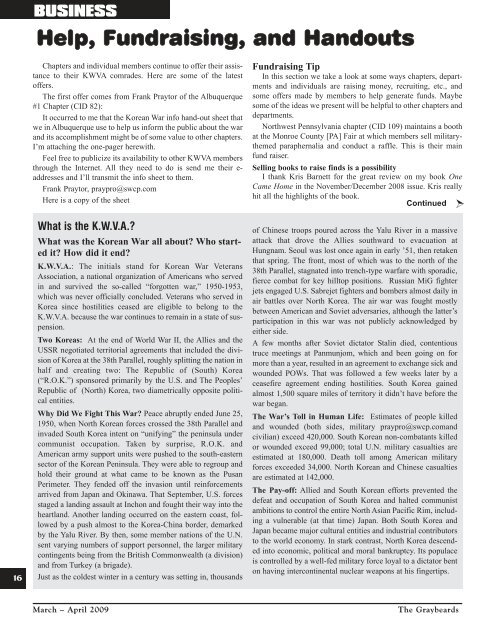Vote! Vote! Vote! - Korean War Veterans Association
Vote! Vote! Vote! - Korean War Veterans Association
Vote! Vote! Vote! - Korean War Veterans Association
You also want an ePaper? Increase the reach of your titles
YUMPU automatically turns print PDFs into web optimized ePapers that Google loves.
BUSINESS<br />
Help, Fundraising, and Handouts<br />
16<br />
Chapters and individual members continue to offer their assistance<br />
to their KWVA comrades. Here are some of the latest<br />
offers.<br />
The first offer comes from Frank Praytor of the Albuquerque<br />
#1 Chapter (CID 82):<br />
It occurred to me that the <strong>Korean</strong> <strong>War</strong> info hand-out sheet that<br />
we in Albuquerque use to help us inform the public about the war<br />
and its accomplishment might be of some value to other chapters.<br />
I’m attaching the one-pager herewith.<br />
Feel free to publicize its availability to other KWVA members<br />
through the Internet. All they need to do is send me their e-<br />
addresses and I’ll transmit the info sheet to them.<br />
Frank Praytor, praypro@swcp.com<br />
Here is a copy of the sheet<br />
What is the K.W.V.A.?<br />
What was the <strong>Korean</strong> <strong>War</strong> all about? Who started<br />
it? How did it end?<br />
K.W.V.A.: The initials stand for <strong>Korean</strong> <strong>War</strong> <strong>Veterans</strong><br />
<strong>Association</strong>, a national organization of Americans who served<br />
in and survived the so-called “forgotten war,” 1950-1953,<br />
which was never officially concluded. <strong>Veterans</strong> who served in<br />
Korea since hostilities ceased are eligible to belong to the<br />
K.W.V.A. because the war continues to remain in a state of suspension.<br />
Two Koreas: At the end of World <strong>War</strong> II, the Allies and the<br />
USSR negotiated territorial agreements that included the division<br />
of Korea at the 38th Parallel, roughly splitting the nation in<br />
half and creating two: The Republic of (South) Korea<br />
(“R.O.K.”) sponsored primarily by the U.S. and The Peoples’<br />
Republic of (North) Korea, two diametrically opposite political<br />
entities.<br />
Why Did We Fight This <strong>War</strong>? Peace abruptly ended June 25,<br />
1950, when North <strong>Korean</strong> forces crossed the 38th Parallel and<br />
invaded South Korea intent on “unifying” the peninsula under<br />
communist occupation. Taken by surprise, R.O.K. and<br />
American army support units were pushed to the south-eastern<br />
sector of the <strong>Korean</strong> Peninsula. They were able to regroup and<br />
hold their ground at what came to be known as the Pusan<br />
Perimeter. They fended off the invasion until reinforcements<br />
arrived from Japan and Okinawa. That September, U.S. forces<br />
staged a landing assault at Inchon and fought their way into the<br />
heartland. Another landing occurred on the eastern coast, followed<br />
by a push almost to the Korea-China border, demarked<br />
by the Yalu River. By then, some member nations of the U.N.<br />
sent varying numbers of support personnel, the larger military<br />
contingents being from the British Commonwealth (a division)<br />
and from Turkey (a brigade).<br />
Just as the coldest winter in a century was setting in, thousands<br />
Fundraising Tip<br />
In this section we take a look at some ways chapters, departments<br />
and individuals are raising money, recruiting, etc., and<br />
some offers made by members to help generate funds. Maybe<br />
some of the ideas we present will be helpful to other chapters and<br />
departments.<br />
Northwest Pennsylvania chapter (CID 109) maintains a booth<br />
at the Monroe County [PA] Fair at which members sell militarythemed<br />
paraphernalia and conduct a raffle. This is their main<br />
fund raiser.<br />
Selling books to raise finds is a possibility<br />
I thank Kris Barnett for the great review on my book One<br />
Came Home in the November/December 2008 issue. Kris really<br />
hit all the highlights of the book.<br />
Continued<br />
of Chinese troops poured across the Yalu River in a massive<br />
attack that drove the Allies southward to evacuation at<br />
Hungnam. Seoul was lost once again in early ’51, then retaken<br />
that spring. The front, most of which was to the north of the<br />
38th Parallel, stagnated into trench-type warfare with sporadic,<br />
fierce combat for key hilltop positions. Russian MiG fighter<br />
jets engaged U.S. Sabrejet fighters and bombers almost daily in<br />
air battles over North Korea. The air war was fought mostly<br />
between American and Soviet adversaries, although the latter’s<br />
participation in this war was not publicly acknowledged by<br />
either side.<br />
A few months after Soviet dictator Stalin died, contentious<br />
truce meetings at Panmunjom, which and been going on for<br />
more than a year, resulted in an agreement to exchange sick and<br />
wounded POWs. That was followed a few weeks later by a<br />
ceasefire agreement ending hostilities. South Korea gained<br />
almost 1,500 square miles of territory it didn’t have before the<br />
war began.<br />
The <strong>War</strong>’s Toll in Human Life: Estimates of people killed<br />
and wounded (both sides, military praypro@swcp.comand<br />
civilian) exceed 420,000. South <strong>Korean</strong> non-combatants killed<br />
or wounded exceed 99,000; total U.N. military casualties are<br />
estimated at 180,000. Death toll among American military<br />
forces exceeded 34,000. North <strong>Korean</strong> and Chinese casualties<br />
are estimated at 142,000.<br />
The Pay-off: Allied and South <strong>Korean</strong> efforts prevented the<br />
defeat and occupation of South Korea and halted communist<br />
ambitions to control the entire North Asian Pacific Rim, including<br />
a vulnerable (at that time) Japan. Both South Korea and<br />
Japan became major cultural entities and industrial contributors<br />
to the world economy. In stark contrast, North Korea descended<br />
into economic, political and moral bankruptcy. Its populace<br />
is controlled by a well-fed military force loyal to a dictator bent<br />
on having intercontinental nuclear weapons at his fingertips.<br />
Ù<br />
March – April 2009<br />
The Graybeards

















